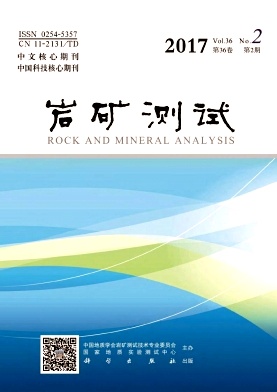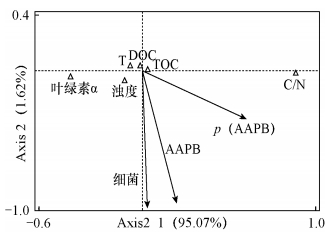| [1] |
Fei Z, Hua L J, Qiang L I, et al.The research of typical microbial functional group reveals a new oceanic carbon sequestration mechanism—A case of innovative method promoting scientific discovery[J].Science China-Earth Sciences, 2016, 59(3):456-463. doi: 10.1007/s11430-015-5202-7
CrossRef Google Scholar
|
| [2] |
Hall K, Arocena J M, Boelhouwers J, et al.The influence of aspect on the biological weathering of granites:Observations from the Kunlun mountains, China[J].Geomorphology, 2005, 67(1-2):171-188. doi: 10.1016/j.geomorph.2004.09.027
CrossRef Google Scholar
|
| [3] |
Kolber Z S, Falkowski P G.Contribution of aerobic photoheterotrophic bacteria to the carbon cycle in the ocean[J].Science, 2001, 292(5526):2492-2495. doi: 10.1126/science.1059707
CrossRef Google Scholar
|
| [4] |
Rawat M, Moroney J V.The regulation of carbonic anhydrase and ribulose-1, 5-bisphosphate carboxylase/oxygenase activase by light and CO2 in chlamydomonas reinhardtii[J].Plant Physiology, 1995, 109(3):937-944. doi: 10.1104/pp.109.3.937
CrossRef Google Scholar
|
| [5] |
Shi L M, Cai Y F, Chen Z T, et al.Diversity and abundance of aerobic anoxygenic phototrophic bacteria in two cyanobacterial bloom-forming lakes in China[J].Annales de Limnologie-International Journal of Limnology, 2010, 46(4):233-239. doi: 10.1051/limn/2010024
CrossRef Google Scholar
|
| [6] |
Yurkov V, Csotonyi J T.New light on aerobic anoxygenic phototrophs[J].Advances in Photosynthesis and Respiration, 2009, 28:31-55. doi: 10.1007/978-1-4020-8815-5
CrossRef Google Scholar
|
| [7] |
Jiao N Z, Zhang F, Hong N.Significant roles of bacterio chlorophylla supplemental to chlorophylla in the ocean[J].The ISME Journal, 2010, 4(4):595-597. doi: 10.1038/ismej.2009.135
CrossRef Google Scholar
|
| [8] |
焦念志.海洋微型生物生态学[M].北京:科学出版社, 2006:580.
Google Scholar
Jiao N Z.Marine Microbial Ecology[M].Beijing:Science Press, 2006:580.
Google Scholar
|
| [9] |
Sieracki M E, Gilg I C, Thier E C, et al.Distribution of planktonic aerobic anoxygenic photoheterotrophic bacteria in the Northwest Atlantic[J].Limnology and Oceanography, 2006, 51(1):38-46. doi: 10.4319/lo.2006.51.1.0038
CrossRef Google Scholar
|
| [10] |
Koblížek M.Ecology of aerobic anoxygenic phototrophs in aquatic environments[J].FEMS Microbiology Reviews, 2015, 39(6):854-870. doi: 10.1093/femsre/fuv032
CrossRef Google Scholar
|
| [11] |
Lew S, Koblížek M, Lew M, et al.Seasonal changes of microbial communities in two shallow peat bog lakes[J].Folia Microbiologica, 2015, 60(2):165-175. doi: 10.1007/s12223-014-0352-0
CrossRef Google Scholar
|
| [12] |
Hojerová E, Mašín M, Brunet C, et al.Distribution and growth of aerobic anoxygenic phototrophs in the mediterranean sea[J].Environmental Microbiology, 2011, 13(10):2717-2725. doi: 10.1111/emi.2011.13.issue-10
CrossRef Google Scholar
|
| [13] |
Mašín M, Ĉuperová Z, Hojerová E, et al.Distribution of aerobic anoxygenic phototrophs in glacial lakes of Northern Europe[J].Aquatic Microbial Ecology, 2012, 66(1):77-86. doi: 10.3354/ame01558
CrossRef Google Scholar
|
| [14] |
Caliz J, Casamayor E O.Environmental controls and composition of anoxygenic photoheterotrophs in ultraoligotrophic high-altitude lakes (Central Pyrenees)[J].Environmental Microbiology Reports, 2014, 6(2):145-151. doi: 10.1111/1758-2229.12142
CrossRef Google Scholar
|
| [15] |
Fauteux L, Cottrell M T, Kirchman D L, et al.Patterns in abundance, cell size and pigment content of aerobic anoxygenic phototrophic bacteria along environmental gradients in Northern Lakes[J].PLoS One, 2015, 10(4):e0124035. doi: 10.1371/journal.pone.0124035
CrossRef Google Scholar
|
| [16] |
Lew S, Lew M, Koblížek M.Influence of selected environmental factors on the abundance of aerobic anoxygenic phototrophs in peat-bog lakes[J].Environmental Science and Pollution Research, 2016, 23(14):13853-13863. doi: 10.1007/s11356-016-6521-8
CrossRef Google Scholar
|
| [17] |
Jonsson A, Meili M, Bergström A K, et al.Whole-lake mineralization of allochthonous and autochthonous organic carbon in a large humiclake (Örträsket N, Sweden)[J].Limnology and Oceanography, 2001, 46(7):1691-1700. doi: 10.4319/lo.2001.46.7.1691
CrossRef Google Scholar
|
| [18] |
曹建华, 袁道先, 潘根兴, 等.岩溶动力系统中的生物作用机理初探[J].地学前缘, 2001, 8(1):203-209.
Google Scholar
Cao J H, Yuan D X, Pan G X, et al.Preliminary study on biological action in karst dynamic system[J].Earth Science Frontier, 2001, 8(1):203-209.
Google Scholar
|
| [19] |
周玉婵, 曹建华, 李小方.水化学对水体着生微型生物群落组成与丰度的影响——以桂林毛村表层岩溶泉、砂页岩裂隙泉为例[J].中国岩溶, 2008, 27(3):261-265.
Google Scholar
Zhou Y C, Cao J H, Li X F.Comparison of periphyton community composition and abundance under different hydro-chemical influences between epikarst spring and sand-shale fissure spring in Maocun, Guilin[J].Carsologica Sinica, 2008, 27(3):261-265.
Google Scholar
|
| [20] |
李强, 靳振江.岩溶生物地球化学研究的进展与问题[J].中国岩溶, 2016, 35(4):349-356.
Google Scholar
Li Q, Jin Z J.Perspectives on karst biogeochemistry[J].Carsologica Sinica, 2016, 35(4):349-356.
Google Scholar
|
| [21] |
Muyzer G, Waal E C D, Uitterlinden A G.Profiling of complex microbial populations by denaturing gradient gel electrophoresis analysis of polymerase chain reaction-amplified genes coding for 16S rRNA[J].Applied and Environmental Microbiology, 1993, 59(3):695-700.
Google Scholar
|
| [22] |
陈晓洁, 曾永辉, 简纪常, 等.玛珥湖好氧不产氧光合细菌pufM基因DNA和mRNA的定量及多样性分析[J].微生物学通报, 2012, 39:1560-1572.
Google Scholar
Chen X J, Zeng Y H, Jian J C, et al.Genetic diversity and quantification of aerobic anoxygenic phototrophic bacteria in Hugangyan Maar lake based on pufM DNA and mRNA analysis[J].Microbiology China, 2012, 39:1560-1572.
Google Scholar
|
| [23] |
Jin Z, Tai J, Pan G, et al.Comparison of soil organic carbon, microbial diversity and enzyme activity of wetlands and rice paddies in Jingjiang area of Hubei, China[J].Scientia Agricultura Sinica, 2012, 45:3773-3781.
Google Scholar
|
| [24] |
William M, Lewis J.A revised classification of lakes based on mixing[J].Canadian Journal of Fisheries and Aquatic Sciences, 1983, 40(10):1779-1787. doi: 10.1139/f83-207
CrossRef Google Scholar
|
| [25] |
Ruhl N, Deangelis H, Crosby A M, et al.Applying a reservoir functional-zone paradigm to littoral bluegills:Differences in length and catch frequency?[J].PeerJ, 2014, 2:e528. doi: 10.7717/peerj.528
CrossRef Google Scholar
|
| [26] |
陈静生, 王飞越, 何大伟, 等.黄河水质地球化学[J].地学前缘, 2006, 13(1):58-73.
Google Scholar
Chen J S, Wang F Y, He D W, et al.Geochemistry of water quality of the Yellow River basin[J].Earth Science Frontiers, 2006, 13(1):58-73.
Google Scholar
|
| [27] |
刘文. 亚热带不同地质背景水库碳转移过程的研究[D]. 重庆: 西南大学, 2015.
Google Scholar
Liu W.A Study on Carbon Migration Processes in Reservoir with Different Geological Setting in Subtropical Areas, SW China[D].Chongqing:Southwest University, 2015.
Google Scholar
|
| [28] |
Zigah P K, Minor E C, Werne J P.Radiocarbon and stable-isotope geochemistry of organic and inorganic carbon in lake superior[J].Global Biogeochemical Cycles, 2012, 26(1):1346.
Google Scholar
|
| [29] |
Li W, Wu F, Liu C, et al.Temporal and spatial distributions of dissolved organic carbon and nitrogen in two small lakes on the Southwestern China plateau[J].Limnology, 2008, 9(2):163-171. doi: 10.1007/s10201-008-0241-9
CrossRef Google Scholar
|
| [30] |
蔡庆华, 刘建康.评价湖泊富营养化的一个综合模型[J].应用生态学报, 2002, 13(12):1674-1678. doi: 10.3321/j.issn:1001-9332.2002.12.037
CrossRef Google Scholar
Cai Q H, Liu J K.A comprehensive model for assessing lake eutrophication[J].Chinese Journal of Applied Ecology, 2002, 13(12):1674-1678. doi: 10.3321/j.issn:1001-9332.2002.12.037
CrossRef Google Scholar
|
| [31] |
蔡庆华.湖泊富营养化综合评价方法[J].湖泊科学, 1997, 9(1):89-94. doi: 10.18307/1997.0114
CrossRef Google Scholar
Cai Q H.Method for assessing lake eutrophication[J].Journal of Lake Science, 1997, 9(1):89-94. doi: 10.18307/1997.0114
CrossRef Google Scholar
|
| [32] |
高坤乾, 顾继光, 韩博平.三座不同营养类型水库春季细菌生理群分布特征[J].生态环境, 2006, 15(3):469-474.
Google Scholar
Gao K Q, Gu J G, Han B P.Spatial distribution of heterotrophic bacteria, phosphobacteria and nitrogen-cycle bacteria among different types of reservoirs in spring[J].Geology and Environment, 2006, 15(3):469-474.
Google Scholar
|
| [33] |
张朝能.水体中饱和溶解氧的求算方法探讨[J].环境科学研究, 1999, 12(2):54-55.
Google Scholar
Zhang C N.Study on calculation method of saturation values of dissolved oxygen in waters[J].Research of Environmental Science, 1999, 12(2):54-55.
Google Scholar
|
| [34] |
Vähätalo A V, Wetzel R G.Long-term photochemical and microbial decomposition of wetland-derived dissolved organic matter with alteration of 13C:12C mass ratio[J].Limnology and Oceanography, 2008, 53(4):1387. doi: 10.4319/lo.2008.53.4.1387
CrossRef Google Scholar
|
| [35] |
Raymond P A, Bauer J E.Use of 14C and 13C natural abundances for evaluating riverine, estuarine, and coastal DOC and POC sources and cycling:A review and synthesis[J].Organic Geochemistry, 2001, 32(4):469-485. doi: 10.1016/S0146-6380(00)00190-X
CrossRef Google Scholar
|
| [36] |
Zigah P K, Minor E C, Werne J P, et al.Radiocarbon and stable carbon isotopic insights into provenance and cycling of carbon in lake superior[J].Limnology and Oceanography, 2011, 56(3):867-886. doi: 10.4319/lo.2011.56.3.0867
CrossRef Google Scholar
|
| [37] |
Smith B N, Epstein S.Two categories of 13C/12C ratios for higher plants[J].Plant Physiology, 1971, 47(3):380-384. doi: 10.1104/pp.47.3.380
CrossRef Google Scholar
|
| [38] |
吴莹, 张经, 曹建平, 等.长江流域有机碳同位素地球化学特征[J].青岛海洋大学学报 (自然科学版), 2000, 30(2):309-314.
Google Scholar
Wu Y, Zhang J, Cao J P, et al.The character of carbon isotope geochemistry of the Changjiang drainage basin[J].Journal of Ocean University of Qingdao (Natural Science), 2000, 30(2):309-314.
Google Scholar
|
| [39] |
许斐, 杨守业, 展望, 等.三峡水库建设对长江下游颗粒有机碳通量及碳同位素组成的影响[J].地球化学, 2011, 40(2):199-208.
Google Scholar
Xu F, Yang S Y, Zhan W, et al.Influence of the impoundment of the Three Gorges reservoir on the flux and isotopic composition of particulate organic carbon in the lower Changjiang mainstream[J].Geochimica, 2011, 40(2):199-208.
Google Scholar
|
| [40] |
张彦鹏, 周爱国, 周建伟, 等.石家庄地区地下水中溶解性有机碳同位素特征及其环境指示意义[J].水文地质工程地质, 2013, 40(3):12-18.
Google Scholar
Zhang Y P, Zhou A G, Zhou J W, et al.Characteristics of dissolved organic carbon isotope in groundwater in Shijiazhuang and its environmental implications[J]. Hydrogeology and Engineering Geology, 2013, 40(3):12-18.
Google Scholar
|
| [41] |
于志同, 王秀君, 赵成义, 等.基于多指标分析的博斯腾湖表层沉积物有机碳来源[J].湖泊科学, 2015, 27(5):983-990. doi: 10.18307/2015.0526
CrossRef Google Scholar
Yu Z T, Wang X J, Zhao C Y, et al.Source characterization of organic carbon using elemental, isotopic and nalkanes proxies in surface sediment from Lake Bosten, Xinjiang[J].Journal of Lake Science, 2015, 27(5):983-990. doi: 10.18307/2015.0526
CrossRef Google Scholar
|
| [42] |
张飞, 刘纪化, 李强, 等.从微型生物功能类群研究到海洋储碳机制的新认识——方法创新带动科学发现的一个典型案例[J].中国科学 (地球科学), 2016, 46(1):9-18.
Google Scholar
Zhang F, Liu J H, Li Q, et al.From the microbial function groups research to ocean carbon storage mechanism—A typical case of method innovation in new impetus scientific discovery[J].Science China:Earth Sciences, 2016, 46(1):9-18.
Google Scholar
|
| [43] |
陈晓洁. 湖光岩玛珥湖好氧不产氧光合细菌遗传多样性的分析[D]. 广州: 广东海洋大学, 2012.
Google Scholar
Chen X J.Gentic Diversity of Aerobic Anoxgyenic Phototropic Bacteria in Huguangyan Maar Lake[D].Guangzhou:Guangdong Ocean University, 2012.
Google Scholar
|
| [44] |
Fauteux L, Cottrell M T, Kirchman D L, et al.Patterns in abundance, cell size and pigment content of aerobic anoxygenic ahototrophic bacteria along environmental gradients in Northern Lakes[J].PLoS One, 2015, 10(4):1-17.
Google Scholar
|
| [45] |
焦念志, Michaele E S, 张瑶, 等.好氧不产氧光合异养细菌及其在海洋生态系统中的作用[J].科学通报, 2003, 48(6):530-534.
Google Scholar
Jiao N Z, Michael E S, Zhang Y, et al.Aerobic anoxygenic phototrophic bacteria and the role in ocean ecosystem[J].Chinese Science Bulletin, 2003, 48(6):530-534.
Google Scholar
|
| [46] |
Hauruseu D, Koblížek M.Influence of light on carbon utilization in aerobic anoxygenic phototrophs[J].Applied and Environmental Microbiology, 2012, 78(20):7414-7419. doi: 10.1128/AEM.01747-12
CrossRef Google Scholar
|
| [47] |
Kirchman D L, Hanson T E.Bioenergetics of photoheter-otrophic bacteria in the oceans[J].Environmental Microbiology Reports, 2013, 5(2):188-199. doi: 10.1111/emi4.2013.5.issue-2
CrossRef Google Scholar
|
| [48] |
李强. 环境因子对AAPB的生长和色素表达的影响[D]. 厦门: 厦门大学, 2006.
Google Scholar
Li Q.Effects of Carbon Source and Salinity on Population Structure of Aerobic Anoxygenic Phototrophic Bacteria in Lake Ulansuhai[D].Xiamen:Xiamen University, 2006.
Google Scholar
|
| [49] |
赵吉睿. 碳源和盐度对乌梁素海水体好氧不产氧光合细菌群落结构影响[D]. 呼和浩特: 内蒙古农业大学, 2013: 37-41.
Google Scholar
Zhao J R.Effects of Carbon Source and Salinity on Population Structure of Aerobic Anoxygenic Phototrophic Bacteria in Lake Ulansuhai[D].Hohhot:Inner Mongolia Agricultural University, 2013:37-41.
Google Scholar
|
| [50] |
Jiao N Z, Zhang Y, Zeng Y, et al.Distinct distribution pattern of abundance and diversity of aerobic anoxygenic phototrophic bacteria in the global ocean[J].Environmental Microbiology, 2007, 9(12):3091-3099. doi: 10.1111/emi.2007.9.issue-12
CrossRef Google Scholar
|
| [51] |
焦念志, 骆庭伟, 张瑶, 等.海洋微型生物碳泵——从微型生物生态过程到碳循环机制效应[J].厦门大学学报 (自然科学版), 2011, 50(2):387-401.
Google Scholar
Jiao N Z, Luo T W, Zhang Y, et al.Microbial carbon pump in the oceanfrom microbial ecological process to carbon cycle mechanism[J].Journal of Xiamen University (Natural Science), 2011, 50(2):387-401.
Google Scholar
|
| [52] |
赵子豪. 典型中国海好氧不产氧光合异养细菌 (AAPB) 生长动力学之研究[D]. 厦门: 厦门大学, 2012.
Google Scholar
Zhao Z H.Research of Aerobic Anoxygenic Phototrophic Bacteria (AAPB) Growth Dynamic in Typical China Sea[D].Xiaomen:Xiamen University, 2012.
Google Scholar
|
| [53] |
赵吉睿, 巩瑞红, 李畅游, 等.三种碳源对乌梁素海好氧不产氧光合细菌群落结构的影响[J].湖泊科学, 2014, 26(1):113-120. doi: 10.18307/2014.0114
CrossRef Google Scholar
Zhao J R, Gong R H, Li C Y, et al.Influence of three kinds of carbon source on community structure of aerobic anoxygenic phototrophic bacteria in Lake Ulansuhai[J].Journal of Lake Science, 2014, 26(1):113-120. doi: 10.18307/2014.0114
CrossRef Google Scholar
|







 DownLoad:
DownLoad:
